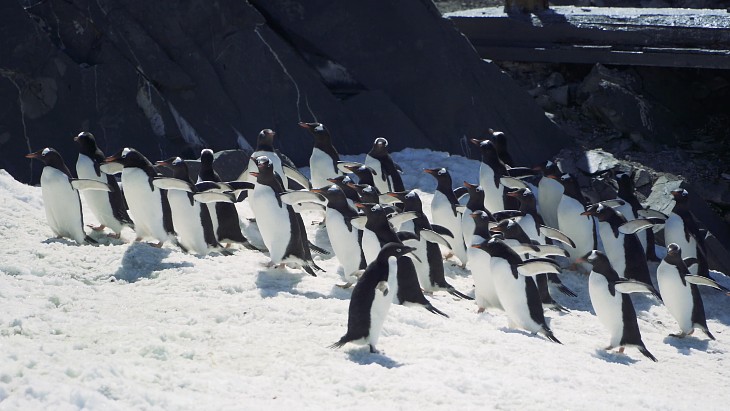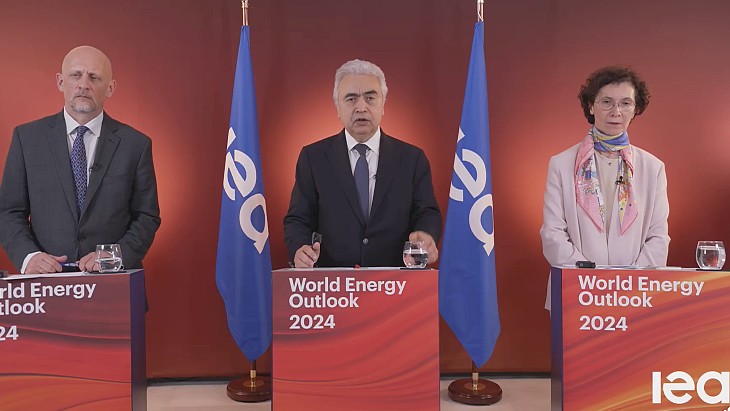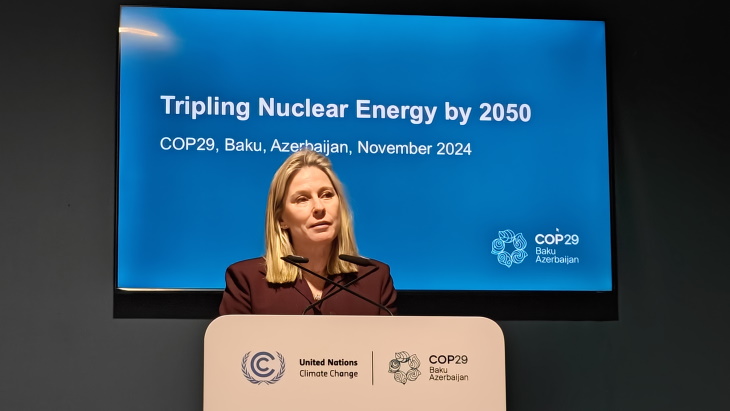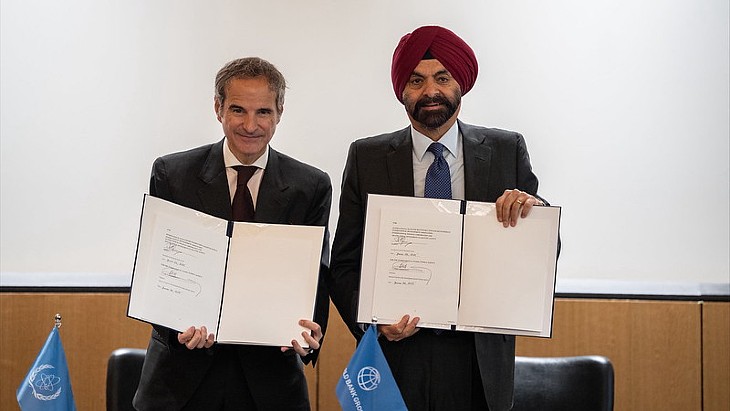Harmony: From initiative to reality
.jpg)
Opening World Nuclear Association Symposium 2018 in London, the Association’s current chairman, Kirill Komarov, stressed the purpose of this year’s event.
“The reason we have gathered here is to discuss how the global community could create the environment in which the Harmony plans for a 1000 GWe of new nuclear capacity by 2050, could become a reality,” Komarov told delegates. “We all understand that there is no sustainable future without nuclear as it is one of the most efficient, environmentally friendly energy sources, which provides electricity in a resilient and sustainable manner.”
Recognition
Komarov, who is first deputy director-general for corporate development and international business at Russia’s Rosatom, noted the “numerous achievements and breakthroughs” for World Nuclear Association over the past year.
“We achieved a heightened level of recognition on the international nuclear arena. New members joined from all over the world, including organisations from Egypt and Bangladesh. This creates value for all existing WNA members and proves the Association’s reputation as a truly global body. It also lays the foundation for the industry to reach the Harmony goal,” he said.
The Association has also managed to reach policy makers directly, especially in countries embarking on a nuclear power programme. As an illustration, he said a very successful World Nuclear Spotlight conference had been held in Indonesia alongside high-level meetings with government officials. The Association is currently working with the next two candidates for hosting the Spotlight - Kazakhstan and Poland, he added. The Association’s director general, Agneta Rising, had also directly addressed the Bulgarian parliament as it considers proceeding with plans for additional reactors.
“In other words, it seems that governments around the world are increasingly approaching the Association,” Komarov said, and international organisations too have shown they are increasingly keen to work with it. He highlighted new cooperation with the World Energy Congress and the UN Economic Commission for Europe.
“Notwithstanding the fact that the larger organisations, of which these are part, have been traditionally reluctant to acknowledge the role of nuclear in addressing the climate and energy challenges, the Harmony programme opens up new opportunities for surging ahead together,” he said.
Climate change
Rising placed the urgency of the Harmony goal into the context of the heatwave affecting countries around the world this summer.
“North, south, east and west were super-heated. For the first time, it was everywhere,” she said. This brought home the fact that emitting more and more greenhouse gases can make such extreme weather events weather events much more common, she added.
“We have to replace fossil fuels as the driving force of our world. We must stop burning them for electricity, and for heat, and also for transport. We need deep decarbonisation and we need to use all today’s clean energy forms beyond their normal deployment for electricity generation. What happens when you make decarbonisation the goal? [A] UN supported study brings the answer: It is a large role for nuclear power,” Rising said.
Working with 16 countries, the UN Sustainable Development Solutions Network set decarbonisation in line with the Paris Agreement’s 2 Degree target as the goal. Each country used their own assumptions about technologies and domestic resources.
They did not all use nuclear, Rising noted, and yet the clean energy mix they account for totals 21% nuclear electricity. And a total of 1053 GW of new nuclear build by 2050, for the countries that represent three-quarters.
“Does that sound familiar?” she asked delegates, referring to Harmony. “We are glad to see this varied study, that included a range of social, political, geographic and technical assumptions conclude as we all have, that nuclear is an essential part of any clean future energy mix.”
On progress towards the Harmony target, Rising highlighted the launch last week of the Association’s third annual edition of the World Nuclear Performance Report.
“As we pass the milestones of 450 operable reactors worldwide and approach the milestone of a total of 400 GWe capacity installed, the performance of the global fleet remains strong with an average capacity factor over 81% - a high we have maintained for 20 years,” she said.
The importance of safety the industry is committed to was proven yesterday, she said, during the earthquake on Japan’s island of Hokkaido, where the Tomari nuclear plant experienced a power outage and was forced to switch to emergency generators. The plant is safe with mobile diesel generators keeping it cool, she said.
Seven new reactors have been connected to the grid in the last year, with China’s Haiyang 2 expected to next week. These connections have added EPR and AP1000 units to the list of advanced reactors in operation, alongside APR-1400 and VVER-1200 reactors, she said.
“The longest run of growth since 2002 has seen nuclear power generation increase for the fifth year running to surpass 2500 TWh again. That’s 10.5% of global electricity demand and we have been building at the fastest rate of construction in 25 year,” she said, adding that the average construction time for a large reactor was only four years and ten months.
As many as 25 new units are already online or scheduled to be in the 2018-2019 period. This, Rising said, puts the industry “broadly on track” to achieve the Harmony goal.
There has been an increasing acknowledgement of nuclear power by policy makers, she said, such as through the Clean Energy Ministerial, the United Nations Sustainable Development Goals, the International Energy Agency and the UN Economic Commission for Europe.
“As the global nuclear industry’s one and only vision for the future of electricity, Harmony has caught the attention and the imagination of policy makers and begun to open doors for this industry.”
Company strategies
Executives from Russian, Chinese and French nuclear power companies each outlined the ways in which Harmony is part of their strategy.
Evgeny Pakermanov, president of Rusatom Overseas, highlighted the importance of international collaboration, particularly in work on innovative technologies.
Rusatom Overseas is a subsidiary of Rosatom, which has commissioned 13 new nuclear power units over the last 11 years, in China, India, Iran and Russia. Its current VVER portfolio includes 35 units. It has 60 units in operation and 41 at the project implementation stage. Novovoronezh II-1 - Rosatom’s first Gen III+ VVER Design - started commercial operation in February last year, and its second, Leningrad II-1 was grid connected in March this year.
Pakermanov described small modular reactor technology as “a truly innovative solution” both on land and at sea. Rosatom has 400 reactor years of experience in nuclear icebreakers, he said, and its Akademik Lomonosov will next year become the world’s first floating nuclear power plant to be commissioned. Next year, Rosatom will also commission the first nuclear icebreaker to be fully built in modern-day Russia. Arktika is the first of three vessels of Project 22220 which will be able to break through ice 3 meters thick as they escort vessels across the Arctic Ocean.
Work to close the nuclear fuel cycle, with the recycling of used nuclear fuel, is “the future of world nuclear energy”, Pakermanov said. For Rosatom, this includes MBIR - the multipurpose sodium-cooled fast neutron research reactor that is under construction at the site of the Research Institute of Atomic Reactors at Dmitrovgrad. This high-flux fast test reactor has “unique capabilities” and will be open to international participation, Pakermanov said. The same applies, he said, to the International Centre for Neutron Research - based on a high-flux research reactor PIK.
Rosatom commissioned the BN-800 fast neutron reactor at the Beloyarsk nuclear power plant in 2015 and work on the design of the “next Step” - BN-1200 - is nearing completion, he said.
Russia and China intend to develop long-term cooperation in fast neutron reactor technologies and will work together on a floating nuclear power plant, he said.
“The opportunities for partnerships and cooperation are much bigger than for competition,” he said. “Strong collaboration is a key driver for us to move towards a better future together.”
Wang Binghua, chairman of State Nuclear Power Technology Corporation (SNPTC) described China’s 30-year journey from nuclear power newcomer to its position now as a “world-class” reactor vendor and “self-reliant” across the entire nuclear fuel cycle.
China has 42 units in operation with a total installed capacity of 42.44 GWe, ranking fourth in the world. It has 15 units under construction with a total installed capacity of 16.3 GWe, ranking first in the world. China generated a total of 247.5 TWh of nuclear power last, ranking third in the world. Ten Gen-III PWR units, one high-temperature gas-cooled reactor and one fast reactor that feature Gen-IV technology are under construction, he noted.
“China has established a complete nuclear fuel and equipment manufacturing industry, providing 8-10 sets of the main equipment for GW-class Gen-III PWRs every year,” he said. “By 2020, the installed capacity of nuclear power will reach 58 GWe, with 30 GWe under construction and the total capacity of nuclear power units in operation is expected to reach 150 GWe by 2035,” he added.
Over the next ten to 15 years, China will “present a technological landscape dominated by proprietary Gen-III reactors and supported by other advanced nuclear energy systems,” he said.
China is actively exploring the application of nuclear energy on land, at sea and in space, as well as for heating, seawater desalination and hydrogen production, he said.
SNPTC designed China’s first PWR - Qinshan - and China’s first exported nuclear power plant - Chashma in Pakistan. It is the controlling stakeholder in Hongyanhe nuclear power plant in Liaoning Province and in Haiyang nuclear power plant, which is one of the first Gen-III passive PWR AP1000 projects.
The Chinese design CAP1400 is now “the world’s largest passive PWR nuclear power plant with the highest safety class”, he said. This design comprises an availability of 93%, a refueling cycle of 18 months, an average discharge burnup above 52,000 MWd/tU and may be safely operated without operator intervention in the event of an accident for 72 hours.
Binghua said he would “echo” the words of Rising in calling for more nuclear power to be installed to help reduce global emissions. China pledged to cut its greenhouse gas emissions per unit of gross domestic product by 60-65% from 2005 levels under a plan submitted to the United Nations three years ago.
“For the Chinese government, the development of nuclear power isn’t simply about meeting energy demand but also about the development of the whole energy structure. We need a certain amount of time to decrease thermal power generation from 65% to a reasonable level and during this process nuclear power has an important role,” he said.
Skills are key
Bernard Fontana, CEO of Framatome, stressed the importance of skills, “both in the here and now and how we plan for new generations”.
“I believe this is our contribution to the Harmony programme. We are a 100% nuclear company following a skills and competency approach. The financial aspect comes second to skills,” he said.
Framatome is a French reactor business created in January this year when Areva NP was sold off, following Areva's bankruptcy. It is owned by EDF, Mitsubishi Heavy Industries and Assystem. It designs, manufactures, and installs components, fuel and instrumentation and control systems for nuclear power plants and offers a full range of reactor services. It has 14,000 employees worldwide and holds around 3500 patents covering some 680 inventions. It operates on more than 250 reactors worldwide.
“Every time there is a new nuclear reactor, we are committed to support it over 60, 70, 80 years. That is a commitment to long-term nuclear skills,” Fontana said.
This commitment includes a digitisation programme, he said, which enhances the company’s ability to serve customers as well as to increase safety and efficiency.
“There are more people working on documents for the safety guarantee of equipment than there are working on the technology,” he said.
With the French government aiming to reduce the share of nuclear in the country’s electricity mix from 75% to 50%, Fontana said that for as long as there is no solution to energy storage, baseload electricity supply will be required.
Commitment to nuclear power is a commitment to the future, he said, “which is why we are able to attract people for the whole of their professional lives. And it’s why our industry is so exciting.”

_99697.jpg)







..._58412.jpg)

